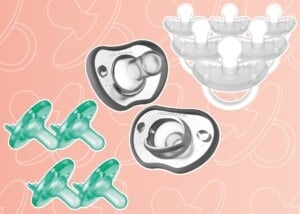Whether a newly breastfeeding mom or a seasoned pro, you have heard at least one myth about breastfeeding. I guess myths come with the territory when it comes to a practice that has been around forever. When people talk about things they have heard regarding breastfeeding or discuss their experiences, they can impact your views and thoughts. Therefore, it is always essential to research what is true and what is a myth about breastfeeding.
Some myths have been around for so long that you may have heard them a million times, and they might sound true. We are going to break some of these long-standing breastfeeding myths down.
1. Myth: Breastfeeding is Painful
When you start to breastfeed, especially with your first baby, it is true that you may feel some discomfort. Your nipples can be sensitive during your first sessions. If you feel persistent pain, something is most likely going on, so it’s time to reach out to your lactation consultant. They will assess what is going on and look at your baby’s latch, feeding position, oral anatomy, and suck. From here, they will create a plan to make sure you are not feeding in pain.1
2. Myth: Never Give a Baby a Pacifier While Breastfeeding
The age-old question: Can I give my baby a pacifier when they are breastfeeding? The short answer is yes. The American Academy of Pediatrics (AAP) says the parent’s use of a pacifier is a personal decision. Research has shown there is no significant impact on breastfeeding duration when a healthy infant uses a pacifier for up to 4 months.2
3. Myth: You Cannot Breastfeed If You Have Inverted Nipples
Many women with inverted nipples can breastfeed their babies. How the nipple looks “at rest” can be very deceiving and feed into this myth.
There are a few things to keep in mind when breastfeeding with inverted nipples:
- Before latching, stimulate the nipple to help evert the nipple. Stimulation could be in the form of massage, a cold cloth, or even a breast pump.1
- The baby should have a deep latch, far back on the mother’s areola. With this positioning and latch, the baby’s sucking will help draw out and extend the mother’s nipple.1
- A nipple shield can help assist a baby with latching. It is best to speak with your lactation consultant to learn how to use the nipple shield properly.1
Although breastfeeding with inverted nipples will likely require a bit more effort from the mom, it is not impossible, and many have succeeded. To help navigate breastfeeding with inverted nipples, reach out to a lactation consultant for support and guidance.
4. Myth: Breastfeeding is Easy
Breastfeeding is a beautiful experience but usually does not come without a few hurdles, and every mother and baby duo will have a unique breastfeeding journey. Challenges may arise initially for some, whereas others might encounter hurdles. You never know what your journey will look like. If available in your hospital, try to see a lactation consultant or breastfeeding-knowledgeable healthcare team member before you head home. They can assess how your baby is breastfeeding and answer your questions. Lactation consultants are experts in all things breastfeeding. If you have concerns or are feeling lost in your breastfeeding journey, be sure to reach out for help.
5. Myth: Skin-to-skin Contact is Not That Important
Skin-to-skin is at the top of the list as one of the most helpful tools to facilitate a breastfeeding relationship, especially in the first few hours after your baby’s birth. When a baby is born healthy, with no complications, one of the best things you can do is keep you and your baby in a chest-to-chest position for a few hours after birth. The benefits are significant, like:1
- Helping stabilize baby’s temperature and glucose levels.
- Reducing baby’s stress.
- Babies can suck more effectively at the breast.
- More success at the first post-birth breastfeeding.
- Longer exclusively breastfeeding relationships.
- A bonding experience for both mom and baby.
6. Myth: Large Breasts Mean I Will Have Tons of Milk
The reality is the size of your breasts does not affect the amount of milk you can produce. Breastfeeding is a “supply and demand” system: The more milk you remove, the more the body will produce. As your baby removes milk while breastfeeding, it signals to the body that it needs to make more milk.1
7. Myth: My Workplace Won’t Allow Me to Pump; I Might Have to Wean My Baby Sooner
The Patient Protection and Affordable Care Act requires employers to give breaks to breastfeeding mothers and provide a private area for mothers to express breast milk while at work.2 The law says an employer should provide a “reasonable break time” for one year after the child is born to express breast milk.4
However, an employer with 50 employees or fewer does not need to follow the requirements for breastfeeding mothers.5
Speaking with your employer before you return to work is always a good idea. Discuss your pumping needs and devise a plan so you know what to expect when you return. The end of maternity leave is always challenging, so be prepared when you return. And having time to pump and access to a space at work can help give your baby all the wonderful benefits of breast milk, even when you are apart.
8. Myth: I Will Lose All the ‘Baby Weight’ From Just Breastfeeding
Breastfeeding is demanding on the body. A breastfeeding mom will burn between 500 and 700 extra calories per day. Although this might seem like a lot, there are other factors regarding postpartum weight loss, such as your diet and physical activity levels.6 Some studies have shown that breastfeeding has a negligible impact on a mother’s postpartum weight loss, but the numbers are not significant.7,8 Many may wish this myth was true, but unfortunately, you will not lose all your baby weight simply from breastfeeding.
9. Myth: My Baby is Nursing More Often, So I Must Not Have Enough Milk
It is normal for babies to go through periods where they seem to be feeding more frequently. This increase is commonly called cluster feeding. Cluster feedings usually occur when your baby is going through a growth spurt. By increasing the number of times they feed, your baby helps you increase your milk supply to meet their growing needs. As your supply increases, you will likely see your baby’s feeding frequency decrease.12
10. Myth: There are Special Supplements That Help You Make Enough Milk for Your Baby
Today’s world is full of products — and really good marketing campaigns — that might have you thinking, “I need that to be successful with breastfeeding.” Everywhere you look, there is a new herbal supplement, special breastfeeding cookies, or teas marketed to breastfeeding moms. Before you make a purchase, know that most moms are equipped to produce enough milk to meet their little ones’ needs. By feeding your baby on demand (when hungry) and expressing milk when you are away from your baby appropriately, your body will continue to make milk to keep up with your growing baby.
If you have concerns about your milk supply, don’t hesitate to contact your healthcare team and lactation consultants for guidance and support.
11. Myth: I Can Drink Alcohol While Breastfeeding If I ‘Pump and Dump’
When breastfeeding, moms can pass alcohol through breast milk to their babies. It is untrue that “pumping and dumping” will remove the alcohol from your breast milk quicker. Just as the level of alcohol in your blood decreases over time, it does the same in your breast milk. But if alcohol is in your blood, it will be in your breast milk.2
12. Myth: There is No Way to Tell If My Baby is Getting Enough Milk If I’m Only Breastfeeding
The first days postpartum can be stressful when your baby’s weight is a constant topic with your healthcare team. At each pediatrician visit, you hear how much weight has been lost or if they are back to their birth weight. It is not uncommon to think, “How much milk is my baby getting from breastfeeding, and is it enough?” Although you are not directly measuring the amount of milk your baby receives at each feeding, there are a few promising signs and indicators your baby is getting everything they need.
Common signs your baby is receiving enough breastmilk are:
- Diaper output. Your baby is having frequent wet diapers and stools. In the first days, your baby’s poop will be dark, almost blackish, and slowly change from greenish to yellow as the days go on.1,9
- Baby is latching well, and you hear your baby swallow as they are sucking.1
- Baby is feeding 8-12 times per day.1
- Appropriate weight gain after the first few days after birth.9
It is helpful to keep a feeding and output log. This will help you remember when your baby last ate and how many wet and dirty diapers they have had. The first few days postpartum can be a blur, so keeping a log can be very helpful.
13. Myth: I Can’t Take Any Medications While Breastfeeding
Most medications are breastfeeding-safe, but there are a limited number of them that you should not take and are contraindicated while breastfeeding. If you encounter a drug incompatible with breastfeeding, there is usually a safe alternative your provider can prescribe. Always consult with your healthcare provider to ensure your medication is breastfeeding-safe. The AAP recommends the Drug and Lactation Database (LactMed) be referenced for information on maternal medications and breastfeeding safety.2
14. Myth: My Partner Won’t Need to Do Anything at Night
This myth leads to two critical points for parents: teamwork and communication. As a breastfeeding mom, yes, you will be feeding, but so much more goes into parenting, especially those first few weeks when your spouse can lend a very helpful hand. With a lack of sleep, tensions can run high, so check in with your partner daily and communicate what they could be doing to be helpful and supportive.
Some examples include:
- Ask your partner to bring the baby to you when it is time to feed during the night.
- After the feeding is complete, ask the partner to burp the baby, change their diaper if needed, and lay them back down.
- If you must pump during the night, ask your partner to help you take the expressed milk to the refrigerator and wash the pump parts.
- Ask your partner to stay up and talk with you while you feed the baby in the middle of the night.
Communication is key! Start having these conversations before your baby is born. Although things may change once the baby arrives, it is good to start the conversation about needing support and which tasks might be helpful for your spouse to contribute.
15. Myth: I Can’t Get Pregnant If I Am Breastfeeding
While exclusively breastfeeding can delay the return of your ovulation cycle, it is essential to note that breastfeeding alone is not a reliable source of contraception. If you are an exclusively breastfeeding mom, your pregnancy chances decrease during the first six months postpartum if your baby’s only feeding method is at the breast.10
Every woman’s body is different. You could become pregnant while breastfeeding, especially if your period has returned, your baby is not exclusively being breastfed, your baby begins sleeping through the night and going long stretches without feeding at the breast, your baby is eating solid foods, and you are decreasing the number of times baby breastfeeds each day.11
Speaking with your healthcare team about contraceptive options while breastfeeding is best.
Breastfeeding myths have been circulating for years. If you ever question something you have heard related to breastfeeding, find credible sources to reference or reach out to a lactation consultant for clarification.











